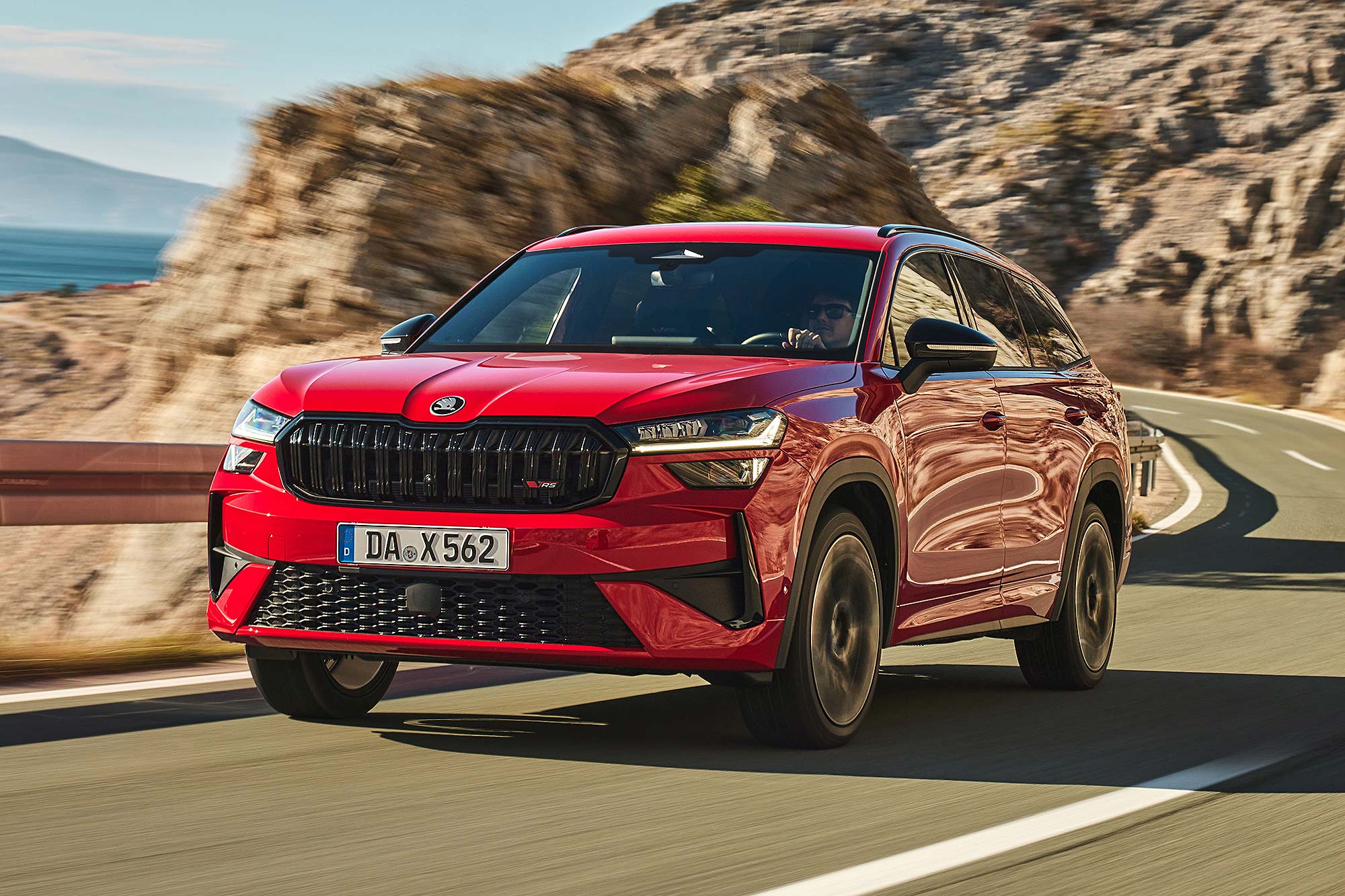Skoda Kodiaq vRS Review 2025: Price, specs & boot space
Written by Richard Aucock
Quick overview
Pros
- Stylish vRS makeover outside and in
- Characterful engine sound
- Extremely practical with seven-seat flexibility
Cons
- Expensive
- Doesn’t have diesel-like fuel economy
- Ride can be a bit jiggly on rough roads
Verdict: Is the Skoda Kodiaq vRS a good car?
“The Skoda Kodiaq vRS is a sportier version of the regular Skoda Kodiaq large seven-seat SUV, with extra performance from its revvy turbo petrol engine, and extra dynamism from tuned-up suspension. A vRS styling makeover outside and in sets it apart from other models, too. Prices reflect its range-topping status, and the engine doesn’t have the tax-friendly efficiency of other models, but as a fun halo car, the Skoda Kodiaq vRS is an appealing yet still family-friendly choice.”
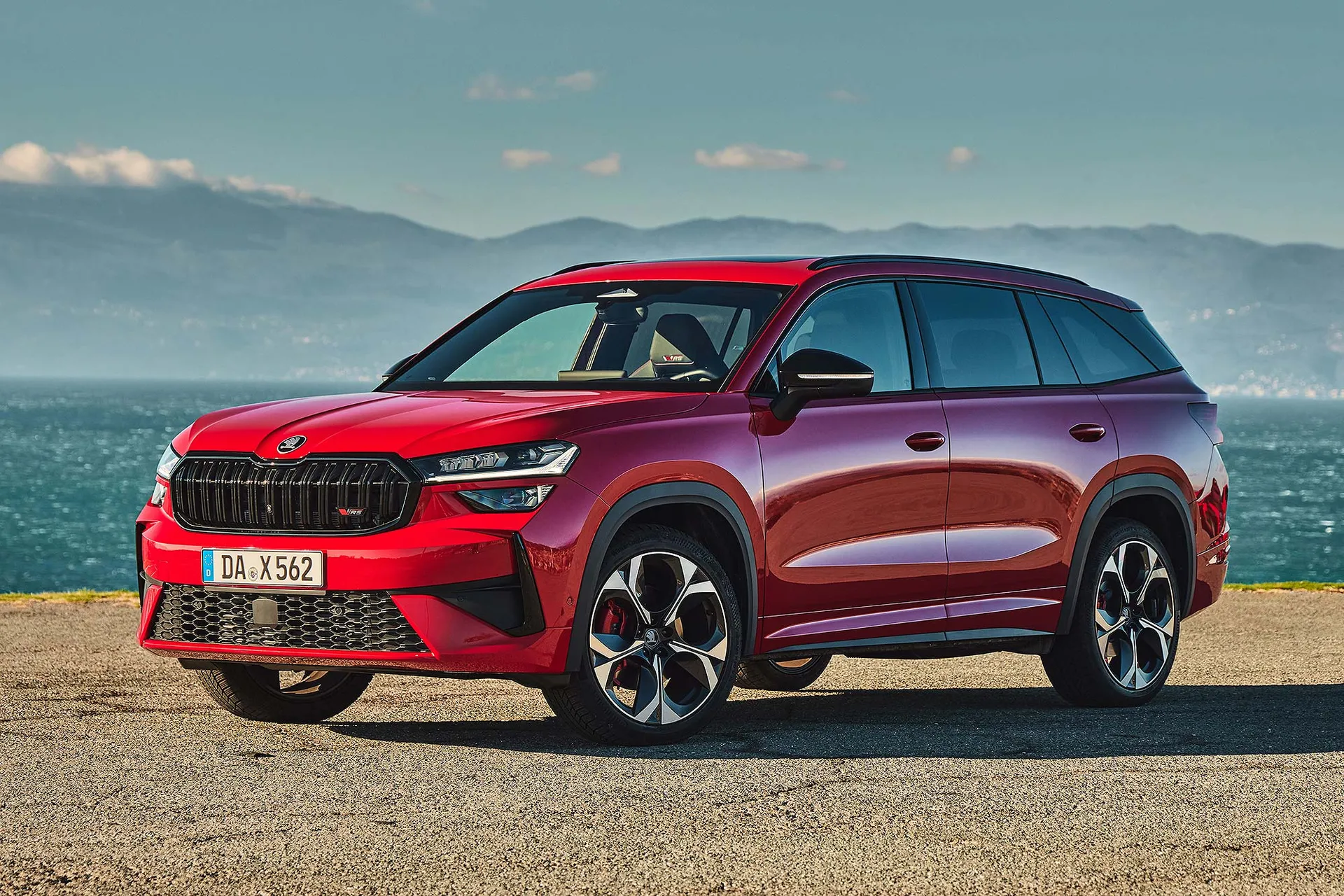
The Skoda Kodiaq vRS is the high-performance version of the popular Skoda Kodiaq seven-seat large SUV. It’s aimed at families who want an added dose of speed, style and dynamism without compromising on three-row practicality and a big boot.
Whereas some older Skoda Kodiaq vRS had a diesel engine, the latest model uses a 2.0-litre TSI turbo petrol engine. It’s actually the same engine used in the Volkswagen Golf GTI (and the Octavia vRS for that matter) – even down to matching its 265PS power output. Skoda pairs it with a DSG automatic gearbox and all-wheel drive 4x4 running gear.
Compared to regular models, the Skoda Kodiaq vRS stands out with a unique design package that includes a gloss black finish for the front grille – which includes a horizontal light strip – along with the D-pillar and window frames. The front bumper is more aggressive and, like all Skoda vRS, there’s a full-width reflector strip at the rear. The rear bumper and side sills are body-colour, while the Skoda lettering and model designation is in black. Polished stainless steel exhaust tips and 20-inch ‘Elias’ polished black, alloy wheels complete the look.
The Skoda Kodiaq vRS has a full makeover inside too. This includes some of the best sports seats we have ever sat on in a family-focused model. Yet this doesn’t come at the expense of practicality, with the Kodiaq vRS offering ample space across all three rows of seats, and a boot that’s bigger than almost any rival, too. Starting up the Skoda Kodiaq vRS sees a vRS welcome logo beamed onto the infotainment system, to add a dash of excitement.
Because the engine is a traditional high-performance petrol unit, fuel economy isn’t a match for some of the other Skoda Kodiaq models. The ride can at times be on the sporty side too. But as a way of adding extra spice to family duties, there’s a lot to like with the Skoda Kodiaq vRS. And by owning one, you’ll definitely stand out from the crowd of other seven-seater SUVs.
Looking for a used car for sale? We've got 100s of Skoda Approved Used Cars for Sale for you to choose from, including a wide range of Skoda Kodiaq SUVs for sale. If you're looking for the older version, you need our used Skoda Kodiaq vRS (2019-2024) review.
Is the Skoda Kodiaq vRS right for you?
There aren’t many high-performance cars as practical as the Skoda Kodiaq vRS out there, which immediately sets it apart. If you want a sporty family holdall, it’s almost certain to be on your list.
The Skoda Kodiaq vRS is a natural step up from a Skoda Octavia vRS, too. While the Octavia is also very practical, the Kodiaq is a bigger car and offers the assertive SUV seating position that so many want these days. The boot is even more practical and its seven-seat flexibility is an added bonus.
The Skoda Kodiaq vRS doesn’t have any plug-in hybrid functionality, so it can’t offer any electric drive capability. Fuel economy, while pretty good, won’t be as low as a frequently-charged PHEV, and it doesn’t have the ultra-low company car tax rates, either. For this reason, the Skoda Kodiaq vRS is more likely to be bought by people spending their own money, rather than as a company car.
There’s only one Skoda Kodiaq vRS model to choose from. It has the 2.0-litre TSI 265 petrol engine, paired with a DSG automatic gearbox that drives all four wheels. There are a few options to choose from, such as a panoramic roof and interior vRS design pack, but most features come as standard – indeed, this high level of standard equipment is another reason why you might choose a Skoda Kodiaq vRS over a premium model such as the BMW X3.
What other cars are similar to the Skoda Kodiaq vRS?
The Skoda Kodiaq vRS is a pretty unique proposition. It has no direct high-performance seven-seat rival. The only similarly-priced seven-seater with a comparable power output is the Volkswagen Tayron 2.0 TSI 265, but the sportiest trim is style-focused R-Line, rather than a full-fat R performance version.
The Land Rover Discovery Sport does have a 270PS plug-in hybrid version, but the emphasis there is even less on a high-performance drive. Meanwhile, the Peugeot 5008 tops out at 195PS in plug-in hybrid guise, while the Nissan X-Trail has a top power output of 213PS. The Mazda CX-80 2.5 PHEV does produce a heady 327PS, but this is again a consequence of the plug-in hybrid drivetrain, rather than the purer performance delivery of the Skoda Kodiaq vRS.
As it is a range-topping sporty car, other rivals include the Audi Q5 and BMW X3, although neither of those offer seven seats.
Comfort and design: Skoda Kodiaq vRS interior
“The Skoda Kodiaq vRS has pumped-up styling that gives it a purposeful appearance, while the interior feels racier and more special than a regular Skoda Kodiaq too. It of course offers an abundance of space as well.”
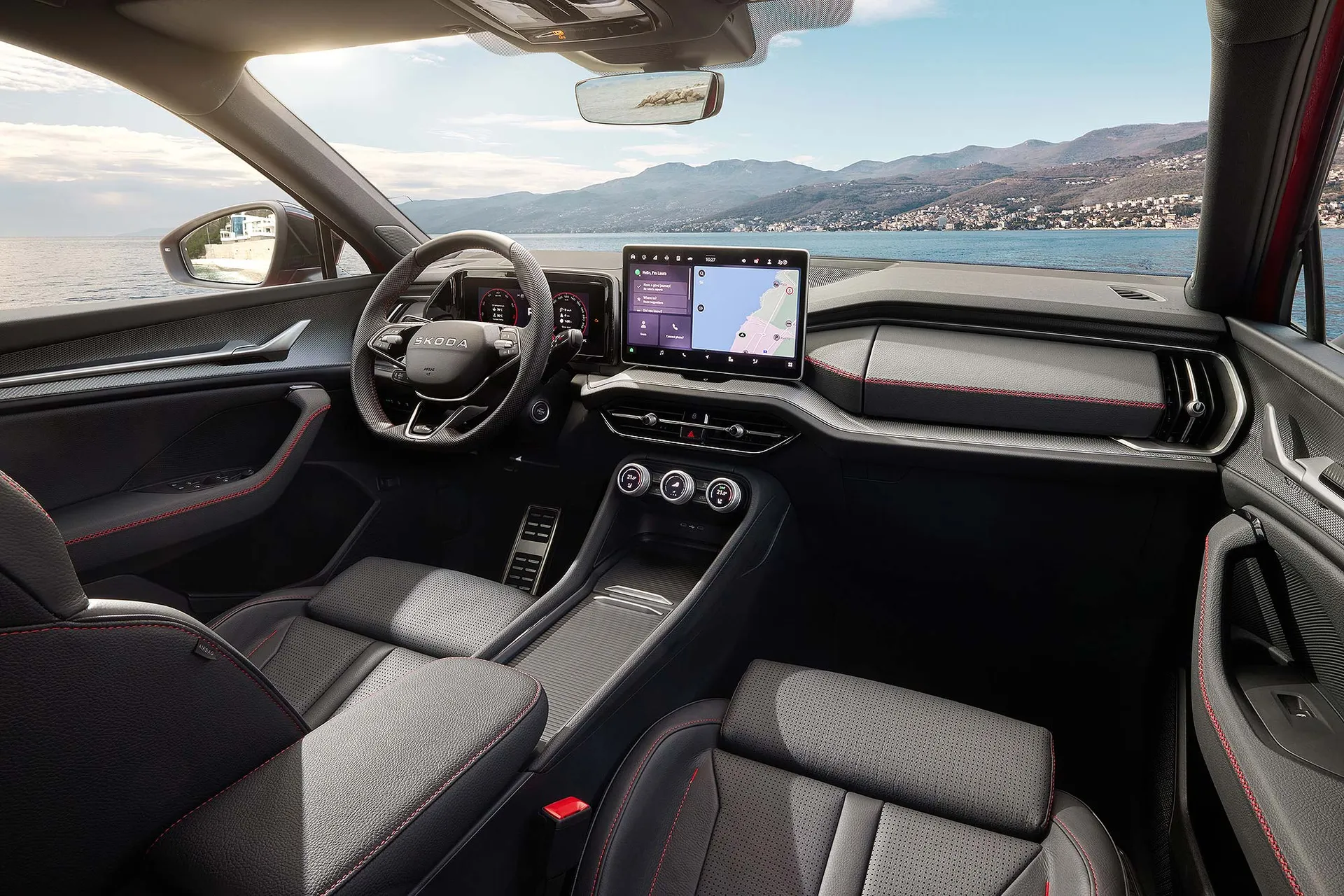
The Skoda Kodiaq vRS has a superb set of sports seats in the front. They are firm, supportive and enveloping. They make you feel really special as soon as you get in. The seats have integrated headrests and are finished in black microsuede and artificial leather upholstery with red contrast stitching. Electric adjustment is standard, and they’re mounted high, for a very commanding view out. The headlining is finished in black to further the sporty look, while the dashboard panels, door inserts and centre armrest are all trimmed in black microsuede.
It's not over the top or excessively focused, and the Skoda Kodiaq vRS has a well-judged interior makeover that adds just enough sportiness compared to a regular model. Again, the seats are the standout – you’ll want to trade up into one for them alone!
Quality and finish
The Skoda Kodiaq vRS has a well-finished, high-quality feel. It seems a step up from most other Skodas, as if it’s been more heavily influenced by its seven-seat sister car, the Volkswagen Tayron. The materials seem more robust and the finish inside is more upmarket than, say, a Skoda Octavia vRS.
This sense of built-in quality extends to its on-road performance. It feels solid and robust, handling even fast-road motoring with assurance. The well-finished exterior appearance of the Skoda Kodiaq also works well in vRS trim, with the sporty additions making it look even more premium.
Infotainment: Touchscreen, USB, sat nav and stereo in the Skoda Kodiaq vRS
The Skoda Kodiaq vRS, like all Skoda Kodiaq vRS, combines a 13.0-inch infotainment system with an 11.25-inch ‘virtual cockpit’ instrument display. The infotainment runs the very latest software which is much easier and more logical to use than older Skoda infotainment systems. It has wireless Apple CarPlay and Android Auto – and two (cooled) wireless charging pads to power this.
The menu structure of the new Skoda Kodiaq vRS’ infotainment is straightforward. It’s based around three basic icons – Home, Car and App. This is easy to understand at-a-glance. The screen can also be configured to showcase your favourites. An optional head-up display augments the other two displays with easy-to-follow icons, even including sat nav instructions.
The Skoda Kodiaq also has the clever Skoda smart dials. These really are ‘smart’ – they comprise three round dials where the heater controls normally sit, each with a built-in colour mini-display. The outer two dials control temperature and seats, while the centre dial is customisable. There are six functions available, of which four can be selected. To scroll through the different settings simply swipe the face of the dial. I found them user-friendly and another clever Skoda touch.
The Skoda Kodiaq vRS has four USB-c ports as standard. They all have a 45W output, with two in the front and two in the rear. This high output is enough to power laptops as well as charge smartphones and tablets. Cleverly, there’s a 15W USB-C port on the back of the interior mirror, to power dashcams.
The new Skoda Kodiaq vRS has a 13-speaker Canton sound system as standard. This comprises eight door panel speakers, a central speaker, two surround speakers and a subwoofer in the space-saver spare wheel. It’s a punchy system, ensuring all seven passengers can hear the stereo clearly.
Space and practicality: Skoda Kodiaq vRS boot space
The Skoda Kodiaq vRS feels very commanding in the front seats. As a large car measuring more than 4.7 metres long, and nearly 1.7 metres tall, it’s a machine you step up into, with the driving position feeling as commanding as a luxury SUV. We’ve mentioned the brilliant seats, but the driving position is also spot-on, with a huge range of adjustment.
The rear seats are fantastic too. There’s so much space there, it almost offers Range Rover levels of accommodation. The abundance of legroom, foot room and headroom really does feel a cut above – even if you’re only planning on regularly driving with four or five people onboard, this combination of space and comfort is reason enough to choose a Skoda Kodiaq vRS. The premium level of fit and finish found in the front extends to the rear, too.
Even with all seven seats in use, the Skoda Kodiaq vRS has a useful 340-litre boot. Fold the third row of seats flat, and it expands to an extremely useful 835 litres, making it one of the biggest boots on the market. Fold the rear seats flat and this dominant space continues – there’s a colossal 2035 litres on offer.
The Skoda Kodiaq vRS’ boot is also intelligently designed. The shape is very user-friendly, with no awkward shapes that will snag bulky loads. Almost every last inch is usable space, and Skoda also includes clever stowage solutions and intelligent design.
Handling and ride quality: What is the Skoda Kodiaq vRS like to drive?
“The Skoda Kodiaq vRS has no shortage of performance from its potent petrol engine, and the tuned chassis offers more grip and control than a regular Skoda Kodiaq too. It’s not a full-on hot hatch equivalent, but is more exciting to drive than standard.”
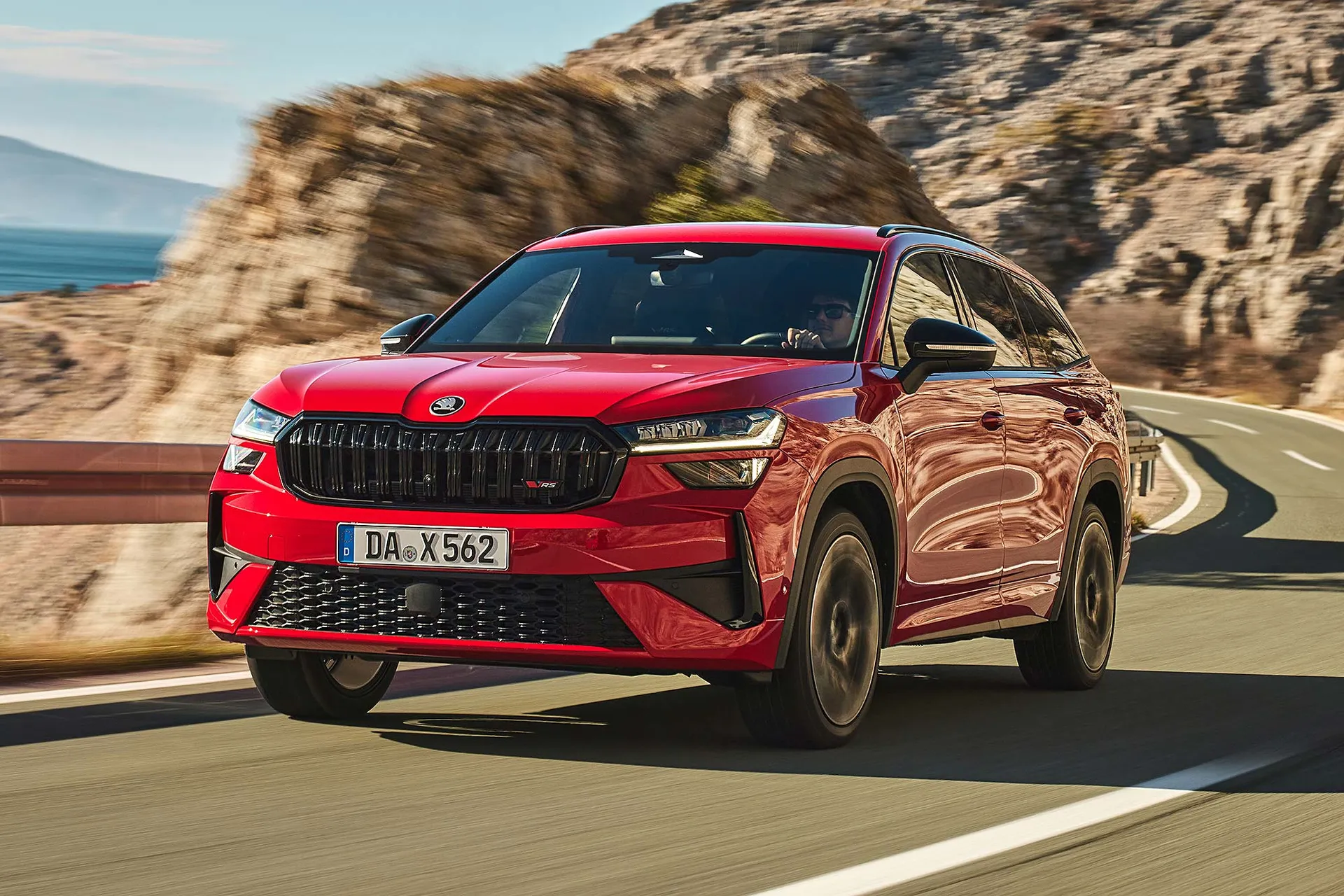
The Skoda Kodiaq vRS is a more focused version of the regular Kodiaq. As well as having larger wheels and tyres as standard, the Skoda Kodiaq vRS is also fitted with DCC Plus Dynamics Chassis Control. This adaptive setup is similar to the tech fitted to the Volkswagen Golf GTI. The range of damping characteristics is extended, with 15 settings ranging from comfortable to sporty. The dampers themselves are continuously adjusted to optimise suspension dynamics and response in real time. There’s a series of modes – Eco Comfort, Normal, Sport, Individual and Snow. Each setting has its own electronic damper profile while the Skoda Kodiaq vRS also has a bespoke rear sports damper setup.
The Skoda Kodiaq vRS doesn’t forget its family-focused SUV roots in all this, though. Compared to the firmer-riding Skoda Octavia vRS, for example, the Skoda Kodiaq vRS has longer-travel suspension that offers more relaxed and less intense progress, particularly in the more comfort-oriented settings. With softer, lighter and less precise steering response, it leads to a car that is a bit more dynamic, but not over-the-top.
The ride of the Skoda Kodiaq vRS can be on the stiff side at times. This is probably a consequence of the large wheels, and the slightly harsh edge at higher speeds on some road surfaces can be a bit pattery. It’s not as stiff as a hot hatch, but there’s definitely less overall comfort than a regular Skoda Kodiaq.
Enthusiastic drivers, of course, may wish for a bit more bite from the Skoda Kodiaq vRS, but for most drivers, it strikes a decent balance. It’s also a very good car for covering long distances in comfort, with the suspension’s extra control and composure over a standard model adding to driver confidence hour after hour. It’s a big car that doesn’t feel big or intimidating to drive, either. Those in the front will also love travelling in it because of those superbly supportive seats.
The Skoda Kodiaq vRS has enhanced braking thanks to ventilated discs both front and rear. The two-piston brake calipers at the front are also larger than on other Skoda Kodiaq models.
What engines and gearboxes are available in the Skoda Kodiaq vRS?
The Skoda Kodiaq vRS has a single engine choice, the petrol-powered 2.0 TSI 265. This 2.0-litre four-cylinder turbo engine is the same one that’s fitted to the latest Volkswagen Golf GTI – meaning it’s a genuine hot hatch engine in a family SUV.
The ‘EA888’ engine is admired in performance car circles for its even power delivery, willingness to rev and, should it be relevant, potential to tune even further.
Straight out the box, the Skoda Kodiaq vRS produces 265PS and 400Nm of torque. The latter figure is the highest of any combustion-engined Skoda. This helps deliver 0-62mph in just 6.4 seconds, which is easily served up by the seven-speed DSG gearbox and 4x4 grip. The gearshifter, by the way, is mounted on the steering column, on the right-hand side. The wiper controls are integrated into the indicator stalk on the left-hand side.
The engine has a free-revving feel, although it does get a bit vocal at higher revs. The DSG automatic gearbox also changes up very early in ‘Comfort’ mode. If you want a more responsive setup, you’ll need to select ‘Sport’, which holds onto gears for longer.
At times, we felt the Skoda Kodiaq vRS engine could be a little too over-eager. The accelerator pedal is very responsive when pulling away, which can make it tricky to not surge forward until you’re used to it. This is particularly so if the stop-start system is active. The automatic ‘creep’ model is also a little intense, so you’ll have to feather the brakes in traffic.
Refinement and noise levels
The Skoda Kodiaq’s surprisingly rorty sports exhaust is an immediate talking point. It gives this family-friendly SUV a muscle car soundtrack. It’s not over-the-top, but is distinctive and obvious. There’s even a speaker that enhances the noise from the outside. However, those who prefer peace and quiet can disable it by selecting a more easy-going drive mode.
The Skoda Kodiaq vRS has acoustic laminated side windows at both the front and rear. This enhances sound insulation and keeps wind noise at bay. While the big 20-inch wheels generate a bit of roar at higher speeds, it’s otherwise reasonably refined, with the engine fading into the background.
Safety equipment: How safe is the Skoda Kodiaq vRS?
The latest Skoda Kodiaq vRS has a full five-star safety rating from Euro NCAP. This was awarded in 2024. It scored 89% for adult occupant protection, 83% for child protection, 82% for vulnerable road users and 78% for safety assist systems.
Standard safety equipment in the Skoda Kodiaq vRS includes ISOFIX child seat fittings on the outer middle row seats, and the front passenger seat with TopTether. The autonomous emergency braking system includes reactions to vehicles, pedestrians and cyclists, and there’s both front cross traffic assist and rear traffic assist. The blind spot detection includes a clever door exit warning.
The Skoda Kodiaq vRS also includes the driver assistance package. This adds adaptative cruise control, while the lane keeping system has semi-automatic vehicle control in an emergency, along with traffic jam assist. The optional driving assistance plus package adds remote park assist, an area-view 360 degree camera, and trained parking that ‘remembers’ the route out of complex spaces.
MPG and fuel costs: What does a Skoda Kodiaq vRS cost to run?
“The Skoda Kodiaq vRS can’t match plug-in hybrid models in terms of fuel efficiency, and some may be surprised by its old-school approach to economy. For a large petrol-powered performance SUV, it’s actually not bad – but a diesel model would be better still.”
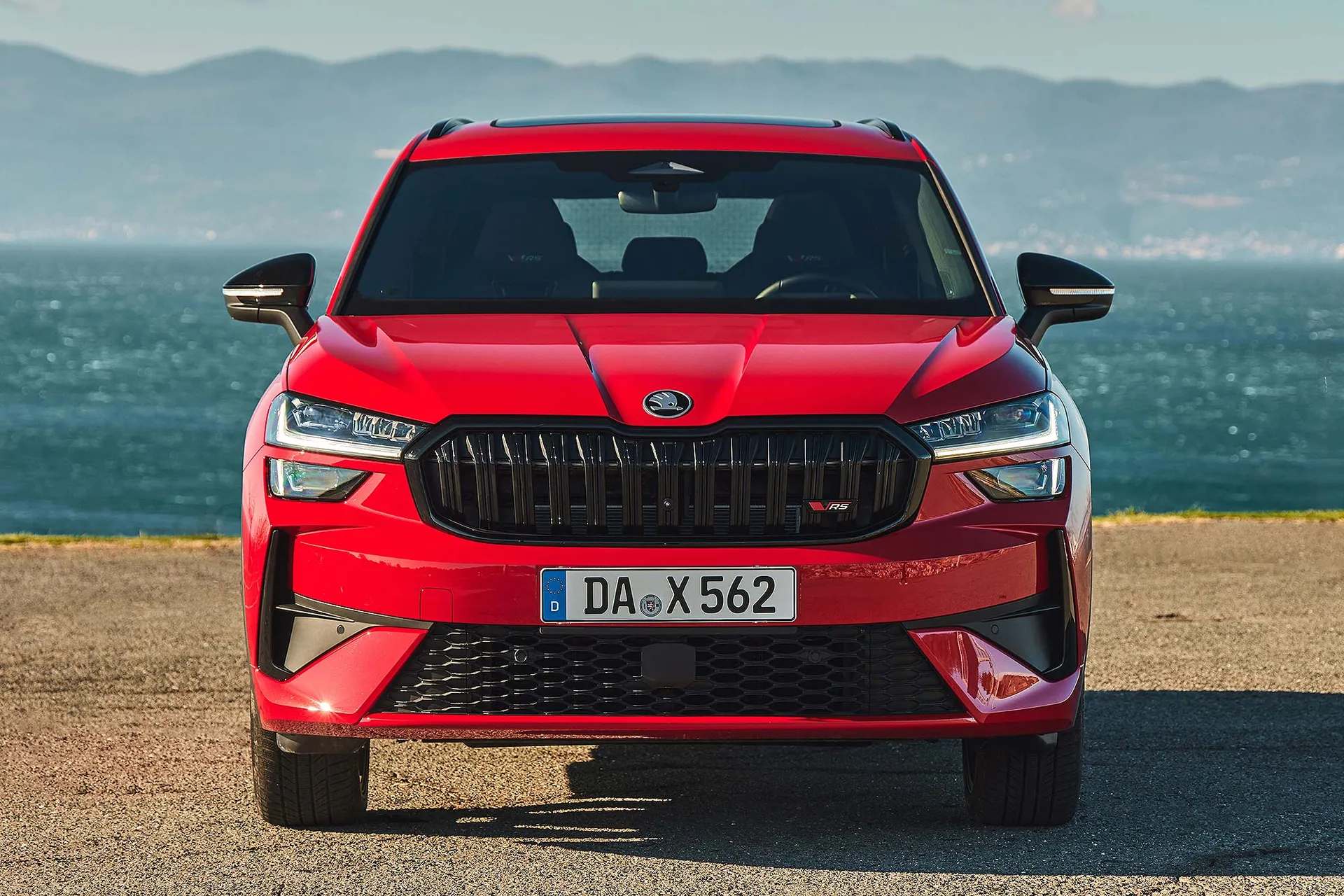
The Skoda Kodiaq vRS has official average fuel economy of 33.9mpg. This is a rather poor figure by modern standards. Although the entry-level Skoda Kodiaq petrol only produces 150PS, it still returns fuel economy of over 47mpg. Even the Golf GTI which donates its engine to the Skoda Kodiaq vRS can average nearly 40mpg.
However, we found things were a bit better in real-world use. When cruising at motorway speeds, the trip computer effortlessly read in the high-30s, and we could achieve 40mpg on a relaxed run. Fuel economy will, however, drop notably if you unleash all the 265PS engine’s performance.
Company car drivers will also find running a Skoda Kodiaq vRS expensive. Because of those 190g/km CO2 emissions, it’s hit with the full 37% rate for Benefit-in-Kind tax. In contrast, the 1.5 TSI iV 204 SportLine has a far more modest 6% Benefit-in-Kind rating, courtesy of CO2 emissions from just 11g/km. It’s for this reason that few company car drivers are expected to pick a Skoda Kodiaq vRS.
Skoda Kodiaq vRS owners can choose either fixed 10,000-mile annual service intervals, or a flexible regime that automatically detects when a service is required. The latter is best for high-mileage drivers, and means the service light will show between 9000 and 20,000 miles, or up to 24 months, whichever comes first.
Skoda Kodiaq vRS reliability and warranty
Skoda is a reliable brand overall, with good feedback from owners. The Skoda Kodiaq vRS features well proven technology, without some of the complicated electric assistance and high-power battery tech seen in plug-in hybrid models. The engine itself also has a track record for dependability, despite its high-performance output.
The Skoda Kodiaq vRS has a three-year, 60,000-mile warranty. Interestingly, the first two years don’t have a mileage cap. This might be of interest for very high-mileage drivers. Optional extended warranties are available for the fourth and fifth years.
Skoda Kodiaq vRS insurance groups and costs
The Skoda Kodiaq vRS has a group 31 insurance rating. This is pretty good for a performance-focused SUV. It’s only four groups higher than the 204PS SportLine version of the Kodiaq, despite its extra pace and more head-turning styling. This should help keep Skoda Kodiaq insurance costs in check.
VED car tax: What is the annual road tax on a Skoda Kodiaq vRS?
With CO2 emissions starting from 190g/km, the Skoda Kodiaq vRS commands a steep £2,190 first-year road tax rate. Of course, this is factored into the on-the-road price, but it’s still an illustration of CO2 emissions that, by modern standards, are high.
What’s more, it’s worth noting that if you choose an optional panoramic glass roof or electric tow bar on the Skoda Kodiaq vRS, CO2 emissions go up to 191g/km. This moves road tax into a higher band, meaning the first year road tax rate is an eye-watering £3,300. This means that while the panoramic sunroof itself is £1760, the effective option cost is a whopping £2870 once the additional road tax is factored in.
Because the Skoda Kodiaq vRS costs more than £40,000, it is subject to the £425 additional rate between years two to six, taking the yearly fee up to £620. After year six, it reverts to the standard rate of £195 a year.
How much should you be paying for a used Skoda Kodiaq vRS?
“Prices for the new Skoda Kodiaq vRS start at just over £53,000, though for that money it comes loaded with kit.”
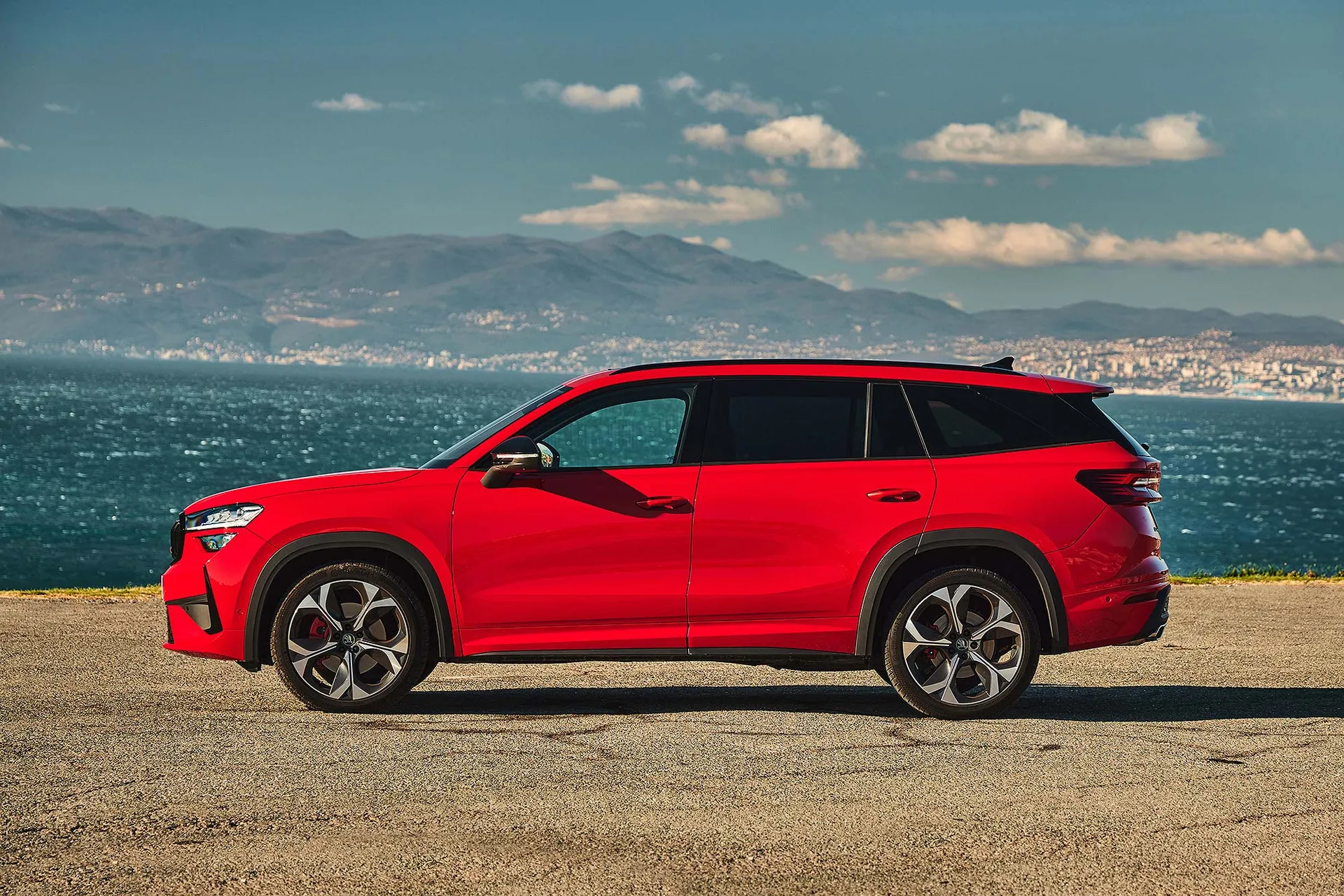
The Skoda Kodiaq vRS is available in earlier diesel and later petrol guise on the used car market, with prices for around £26,000.
You have two choices with used Skoda Kodiaq vRS. You could take the earlier 2.0 BiTDi 240 diesel version, using a highly-tuned but still fuel-efficient 2.0-litre diesel engine. Prices start from around £26,000 for a 2019 car. If you prefer petrol power, the previous Skoda Kodiaq vRS 2.0-litre TSI 245 starts from around £32,000 for a 2022 model.
Trim levels and standard equipment
There is just one trim level of Skoda Kodiaq vRS available, and it has an all-inclusive list of standard equipment. Impressively, all Skoda Kodiaq models have three-zone climate control – meaning driver, front passenger and rear seat passengers can all set their own temperatures – plus heated front seats, front and rear parking sensors, rear-view camera, wireless smartphone charging (with cooling) for two smartphones plus Skoda’s clever configurable smart dials. The 13.0-inch touchscreen is complemented by a 10.25-inch virtual cockpit instrument display.
The Skoda Kodiaq vRS adds adaptive cruise control, dynamic chassis control, 20-inch black polished alloy wheels, red brake calipers and a premium Canton sound system. The tailgate is electrically operated, and has a ‘virtual’ pedal so you can open it with a swing of your leg, while those superb front seats are power adjustable. The front seats have electric lumbar support as well.
The vRS Lounge design selection includes black perforated microsuede and artificial leather upholstery, with black microsuede featuring red cross-stitching on the dashboard. The three-spoke steering wheel is a sporty design, and includes both vRS logo and paddles for the DSG automatic gearbox.
Skoda Kodiaq vRS buyers can choose an optional panoramic sunroof and head-up display, and a ‘driving assistance plus package’ that includes a 360 degree camera and remote park assist. There’s also a vRS suite design selection that includes an even more stylish interior design plus comfort features like ventilated front seats.
High-power LED matrix beam headlights help Skoda Kodiaq vRS drivers make the most of its ample performance during nightfall.
Ask the heycar experts: common questions
Why does the Skoda Kodiaq vRS exhaust sound so good?
How many seats does the Skoda Kodiaq vRS have?
How much is metallic paint on the Skoda Kodiaq vRS?
Get our latest advice, news and offers
Keep me updated by email with the latest advice, news and offers from heycar.
By submitting you agree to our privacy policy
